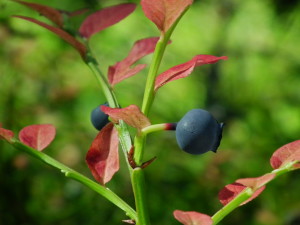The Bilberry plant is a rich source of natural nutrition for the environment of the Nordic region.
Bilberry flowers bloom early in the spring season. they are a pink colored round bell, shaped like a rice paper light shade that is light, round and a delicate structure. The bees pollinate the bilberry flowers as they flower over a 4 week period. Not all flowers appear at the same time, towards the end of the flowering season there are small tiny green berries beginning to shape from where the flower was and had fallen of the stem. The tiny green berries grow gradually over a 8-10 week period and as they get bigger and riper they change color to a dark blue or almost black color.
See bilberry pictures from this link. Summer berry season 2013.

The bilberry fruit has many different trace elements.
Bilberry fruit pulp contains very little fruit acids. They have ample A and B vitamin, manganese, fiber and flavonoids. They are also good as vitamin C, magnesium, and calcium sources. Bilberry berries are also rich in saccharides, or sugars. Flavonoids are so-called antioxidants.
Watch a YouTube video presentation on a Bilberry here: Bilberry
Material composition of the berries
100 g of fresh berries is:
– Protein 0.67 g
– Vitamin A (RE) 7.9 ľg
– Vitamin B1 0.03 mg
– Vitamin B2 0.03 mg
– Vitamin B3 0.6 mg of niacin
– Vitamin B5 or pantothenic acid 0.16 mg
– Vitamin B6 0.06 mg
– Vitamin C 44 mg
– Vitamin E (alpha-DB) 1.88 mg
– Vitamin H or biotin, 1.1 ¶ g
– Phosphorus 20 mg
– 100 mg of potassium
– Calcium 20 mg
– Cobalt <0.5 ľg
– Chrome 2 ľg
– Copper 78 ľg
– Magnesium 9.1 mg
– Manganese 4.6 mg
– Molybdenum <10 g
– Silicon 0.5 mg
– 0.56 mg of iron
– 13 mg of sulfur
– Zinc 0.15 mg
Source: Herbosus.fi

Antioxidants affect the quality of life.
Antioxidants have properties that are beneficial to life and human health, because they protect and prevent oxidation damage to the healthy cells of the body. Here is a link to a web site that has more information on Antioxidants. Antioxidants.
We need Carotenoid’s for molecular cell protection.
The vast research done over many years on human health has yielded results that prove that the Carotenoid’s do positively affect the quality of life. Particularly in the following areas;
• Cardiovascular system.
• Immune system support.
• Healthy Vision system.
• Respiratory function system.
Bilberries are a natural gift for good health, and there are many berries, fruits and vegetables that are equal to this claim, but they are all unique. It is important to go through the list of berries, fruit and vegetables and give them the glory that is due to them. We need them all, they provide nutrition health and vitality to life much more than some other comfort foods that people tend to consume more at times.
Bilberries can be enjoyed early at the breakfast time with cold milk and cereal or with hot porridge and milk. They can also be blitzed and blended into shakes with yogurt and other soft fruit like bananas or mango, paw paw or other soft fruits. Bilberry is great for garnishing dessert plates and fruit salads. They can equally be enjoyed as a fruit snack on their own, or maybe with some yogurt and honey to sweeten it even more. Whatever is your favorite way to enjoy eating bilberries try to crush the tiny seeds as you consume them, they contains a vast range of essential nutrients, happy crunching.
